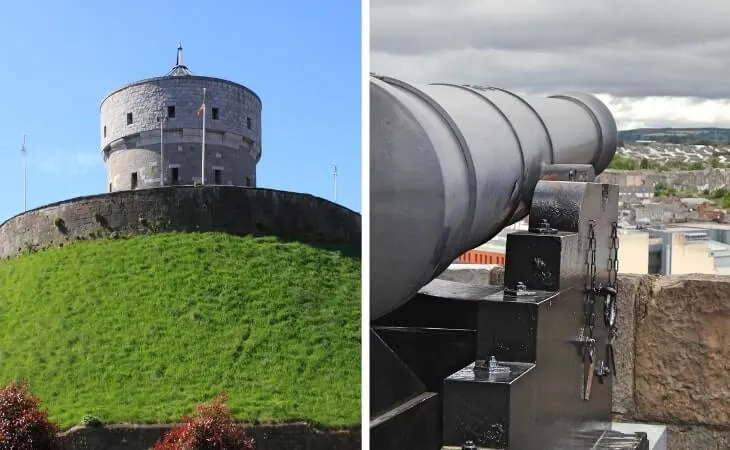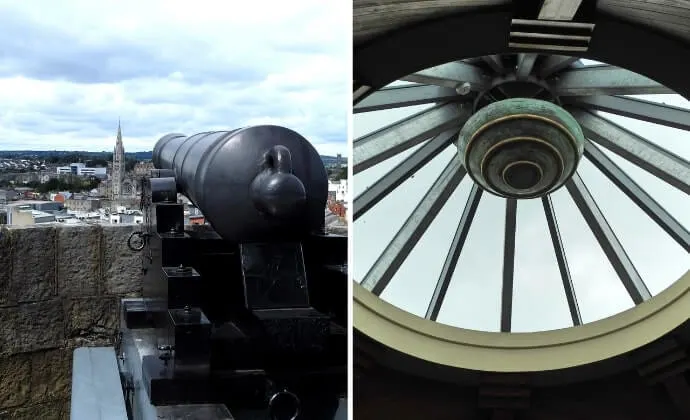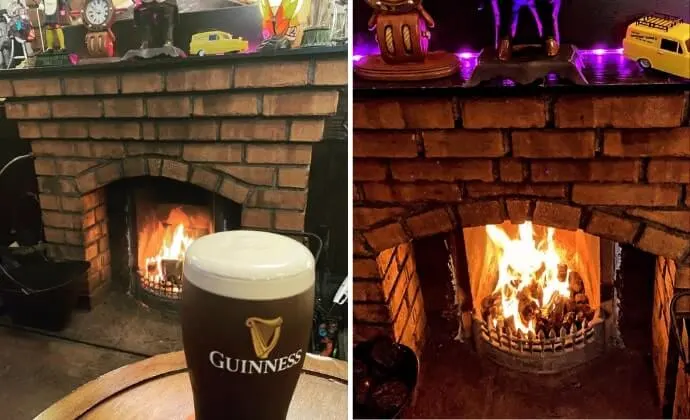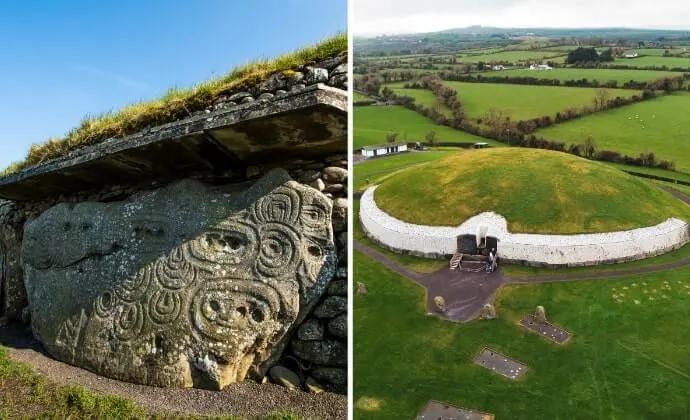If you’re a history buff looking for things to do in Louth, the Millmount Museum is well worth a visit.
The Millmount Museum (or the Millmount Cultural Quarter, as it’s now called) is the oldest surviving centre of settlement in Drogheda.
It’s inside the fort that you’ll discover the dramatic history of the town along with plenty of local tales. There’s also an excellent view from the top!
Some quick need-to-knows about the Millmount Museum

Although a visit to the Millmount Museum is fairly straightforward, there are a few need-to-knows that’ll make your visit that bit more enjoyable.
1. Location
The Museum Millmount is in the centre of Drogheda, perched on a hilltop on the south side of the River Boyne in Louth. Whether you’re arriving on foot from the station or by car, turn off Dublin Road onto Mary Street at the Memorial, opposite the Scotch Hall Shopping Centre. At the top of the hill, turn right into Duleek Street and then left into the Millmount Complex.
2. Parking
There is onsite parking at the Millmount Complex (here on Google Map), or park in the town and walk up the hill.
3. Guided tours
The best way to get the most from your visit to Millmount Museum is on a guided tour. Tickets cost:
- Adult: €8.00
- Child: €4.00
- Family: €20.00
- Concession: €6.00
Things to see and do at the Millmount Museum in Drogheda
You can’t miss the great fort overshadowing Drogheda town. Inside the complex is the Drogheda Museum Millmount and the Martello Tower. It provides wonderful views of the surrounding area.
The town of Drogheda is over 800 years old and the fort is in the Millmount Cultural Quarter. Here’s what you’ll see when you arrive.
1. Millmount Fort

Photos via Shutterstock
The Millmount Fort sits on top of an ancient hill and has a long and interesting history dating back to Norman times. In 1649, the Seige of Drogheda saw Cromwell’s Parliamentarian forces storm the garrison and sack the town with a brutal loss of life. Royalists barricaded themselves inside the fort. They later surrendered and were executed.
The fort was damaged more recently during the Irish Civil War when it was occupied by Anti Treaty forces. It came under heavy shelling by the Irish Free State Army.
The fort complex was restored by Drogheda Corporation and opened as a public museum and attraction in 2000.
2. The Guild and Trade Banners
Exhibitions inside the museum include a unique and colourful collection of Guild Banners dating back over 200 years. Trades such as weavers, carpenters, shoemakers and fishermen all had their own guild and specially designed banner to represent them. Many were hand-painted by Dowth artist, William Reynolds.
The most spectacular Trade Banner is that of the Boyne Fishermen. The three Trades Banners represented The Fishermen, The Labourers and The Brick and Stone Layers. The Labourers Banner probably belonged to a group of Agricultural Labourers.
3. The Industrial History

Photos via Shutterstock
With access to the sea via the River Boyne, Drogheda was well positioned to benefit from the Industrial Revolution in the early 19th century. The port town had its own gasworks by 1832 and the railway connected Drogheda direct with Dublin by 1844.
The town had a pool of skilled labourers, particularly weavers. Soon there were factories and linen mills in operation, supported by smaller businesses such as breweries, distilleries, candle-makers and shoe makers. These are all represented in the fascinating Industrial Heritage Exhibition at Millmount Museum.
Drogheda became a leading centre for Irish linen production and textiles between 1780 and 1820. They introduced professional organisations and guilds, each with their own banner.
4. The Folk Kitchen
Check out the authentic 19th century Irish kitchen exhibition. The old dresser with its willow pattern plates many be familiar to some. The fireplace is surrounded by iron pots and pans.
There’s a settle bed with a straw mattress, a collection of smoothing irons and early appliances such as a washing machine and a manually operated vacuum cleaner.
There’s also a recreated Dairy with butter churns and butter-making equipment. It just shows what a difference the advent of electricity made!
5. The Archaeological and Folklife Exhibition

Photos via Shutterstock
One of the most extensive exhibitions in Millmouth Museum is the archaeological display. As an important port town, Drogheda was visited by many sailing vessels, trading goods. This led to a rich diversity of pottery and earthenware in this international collection of interesting treasures.
The exhibition includes red glazed floor tiles found near Magdalene Tower and dating back to mediaeval times. Other beautiful treasures include a 16th century Lusterware dish from Valencia Spain, a French relief jug decorated with the Madonna and Child, and an early 16th century coat of arms from a barrel coaster.
6. The Geological Collection
The museum also has an eclectic Geological Collection. You can see displays of rare and important geological specimens of rocks.
One of the main displays has a collection of building stones from around the world. Other significant exhibits in the Geological Collection are over 300 samples of granite and marble from around the world.
As well as these colourful displays, this room has geology maps and explanatory boards to show the links between the earth’s resources and the requirements of human society.
Things to do nearby
The Millmount Museum is a short walk away from many of the more popular things to do in Drogheda, with heaps of historical sites a short distance away.
Below, you’ll find everything from heads (yes… heads!) and quirky features to plenty more.
1. Food (or a pint) in the town

Photos via The Railway Tavern on FB
There’s some brilliant old-school pubs in Drogheda, and there’s some excellent restaurants in Drogheda, too, if you’re feeling peckish. Also, if you’re debating staying in the town, nip into our guide to the best hotels in Drogheda!
2. St. Laurence’s Gate (10-minute walk)

Photo left: David Soanes (Shutterstock). Right: Ireland’s Content Pool
St Laurence’s Gate (on the left) is an imposing tower gate which provided access to Drogheda through the fortified town walls. It is considered one of the finest surviving gates in Europe. It consists of two circular towers flanking an archway within the town walls. Built by the Anglo Normans, the walls were completed in 1334. They protected Drogheda against invasion in 1317 and 1642, but in 1649 Cromwell attacked successfully and the Drogheda Massacre ensued.
3. Magdalene Tower (10-minute walk)

Photos via Shutterstock
The Magdalene Tower (on the left) is a local landmark which can be seen for miles. It was originally the bell tower of the 13th century Dominican Friary and the belfry was added later. All that remains is a pointed Gothic arch with two storey above, connected by a spiral staircase. It is topped by battlements damaged by Cromwell’s cannon fire in 1649.
4. Bru na Boinne (20-minute drive)

Photos via Shutterstock
Brú na Bóinne is one of the most popular places to visit in Meath, and it’s home to the ancient burial sites of Newgrange and Knowth. Take a guided tour and learn about the 5,000 year-old passage tombs and megalithic artworks found beneath the grassy mound. The Visitor Centre has informative state-of-the-art displays.
